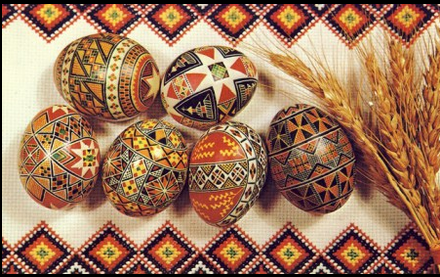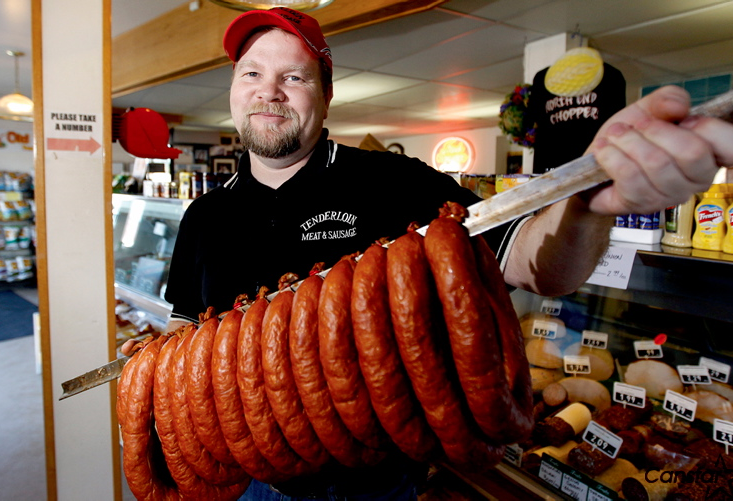Easter is for kid’s right? Well the religious answer to that is No, but in
addition to that, as often as kids were allowed to make Pysanky in my home town
around Easter. Pysanky making is really an adult art, you are playing with fire
literally, the dyes you use are permanent and do not come off of anything (I
actually managed to stain some of my dishes with the stuff... that's right I
stained glass go figure) oh yah! and the dyes are also poisonous. Yet somehow,
wonderful dedicated school teaches in my home town would guide classes of
young students through the process, despite burnt hair, finger and the odd bit
of stained items. No one ever managed to poison themselves.
The smell of bee's was will always takes me back to Easter, the halls in
school were filled with the smell of classes working on Easter Eggs. While I
have memories of burning fingers, and dripping hot wax on myself, I still was
excited to give this a try again. The last time I made a traditional Pysanky I
was maybe between 8-12. I was personally surprised at how my hand eye coordination had improved since I had last attempted to make a Pysanky. I couldn't help but share photos of the kit online with
my friends, and before long I had several people wanting to stop by and work on
the eggs with us.
 Our Egg making station
Our Egg making station
The challenge of getting an Egg Making Station set up in our small one bedroom condo took some thought and planning but I made a fairly decent set up for people to work at. You need dye, bee's wax (generally a black variety is used, but any color of bee's wax will do as long as you can see it on the egg) and a special tool called a kistka, which is a copper funnel attached to a stick with wire, that funnels the wax onto your egg when you heat it over an open flame. You have to draw on the egg with the kistka for each color, anything you cover with the wax stays that color, you must dye your eggs from the lightest color (yellow) to the darkest color (black) you can skip colors but you cannot use a lighter color once the egg had been dyed in a darker one. If you like your egg and want to give it a professional look you can varnish the shell after the dying process.
Pysanky - Image credit She Walks Softly Blog Pysanky are usually empty shells, you blow out the contents of the egg before starting the project, which can make them tricky to dye evenly, but if you want to keep them this is necessary. I know I have no artistic talent so we just left ours eggs whole and created them with the intent they will only last till after Easter. Some Pysanky are stunning works of art just google image search Pysanky and you'll be amazed by the detail and beauty of them.
Please note that if you do create a Pysanky using any kind of raw or boiled egg it is NOT EDIBLE the dye used in making them is not safe for food, if you wish to eat a Pysanky ensure you are using food safe dye. Traditional Pysanky are NEVER consumed (and usually hollow anyway) and regular boiled eggs are in the basket alongside them that will be consumed. Eating or breaking a Pysanky would be akin to eating one of your Great Grand Mother's china plates, or breaking it expecting food to fall out, to put this in a social perspective for anyone who hasn't made one before.
 In addition to Pysanky one egg is reserved to be dyed red this is the krashanki
(alternate spelling: krashanka) you see this egg more
prominently in Greek culture.
In addition to Pysanky one egg is reserved to be dyed red this is the krashanki
(alternate spelling: krashanka) you see this egg more
prominently in Greek culture.
However the uniqueness of the representation of red Eggs at Easter, and traditions surrounding them vary greatly from country to country, and even village to village. In Christianity the symbolism of the red egg is for that of the blood of Christ, or Mary Magdalene. In Ukraine prior to the introduction or Christianity this special egg was a symbol of the rebirth of the sun, and the shells of it were used to communicate with spirits of various origins and using various traditional methods based on the region. I have even heard Ukrainian people refer to the red egg in a similar manor as a Turkish Nazar (this has many other names but is also referred to as the "evil eye" charm) and the intent of the egg is to disperse the negative thoughts or looks that may be given to the basket or its barer. Since at one time in Ukraine Easter baskets were often used to display how prosperous a family was (I have hear of old tales of families using dresser drawers as baskets to display all their food) the "evil eye" thing may have some credit to it. However in conclusion I have to say that the history of the krashanki is too complex for me to narrow down into one story or symbol.
 What I can say about the krashanki is that this egg is edible, traditionally made using an onion skin dye treatment, and is
to be shared among family members when eaten. The egg is the first egg eaten at
sunrise on Easter to bring lent to a close. The egg is cracked and cut by the
father of the family, and then eaten by family members to promote prosperity,
love and strong family ties.
What I can say about the krashanki is that this egg is edible, traditionally made using an onion skin dye treatment, and is
to be shared among family members when eaten. The egg is the first egg eaten at
sunrise on Easter to bring lent to a close. The egg is cracked and cut by the
father of the family, and then eaten by family members to promote prosperity,
love and strong family ties.
As if I haven't listed enough types of eggs here, now we are getting down to are garden variety "Easter Eggs" that are edible hard boiled eggs that you just decorate in an Easter Basket. These eggs in Christianity are symbolic of new life and resurrection. This year I decided to go with a traditional look and since I don't have the artistic talent to make fine detailed Pysanky I decorated my hard boiled eggs with "egg wraps" which are plastic eggs sleeves with designs on them that shrink to fit the egg when place in boiling water. I hope you enjoyed this Eggciting edition of the blog! Happy Easter!
Our Pysanka Kit Please note the mike and Ike's are not part of the traditional egg making process
 Our Egg making station
Our Egg making stationThe challenge of getting an Egg Making Station set up in our small one bedroom condo took some thought and planning but I made a fairly decent set up for people to work at. You need dye, bee's wax (generally a black variety is used, but any color of bee's wax will do as long as you can see it on the egg) and a special tool called a kistka, which is a copper funnel attached to a stick with wire, that funnels the wax onto your egg when you heat it over an open flame. You have to draw on the egg with the kistka for each color, anything you cover with the wax stays that color, you must dye your eggs from the lightest color (yellow) to the darkest color (black) you can skip colors but you cannot use a lighter color once the egg had been dyed in a darker one. If you like your egg and want to give it a professional look you can varnish the shell after the dying process.
Pysanky - Image credit She Walks Softly Blog Pysanky are usually empty shells, you blow out the contents of the egg before starting the project, which can make them tricky to dye evenly, but if you want to keep them this is necessary. I know I have no artistic talent so we just left ours eggs whole and created them with the intent they will only last till after Easter. Some Pysanky are stunning works of art just google image search Pysanky and you'll be amazed by the detail and beauty of them.
Please note that if you do create a Pysanky using any kind of raw or boiled egg it is NOT EDIBLE the dye used in making them is not safe for food, if you wish to eat a Pysanky ensure you are using food safe dye. Traditional Pysanky are NEVER consumed (and usually hollow anyway) and regular boiled eggs are in the basket alongside them that will be consumed. Eating or breaking a Pysanky would be akin to eating one of your Great Grand Mother's china plates, or breaking it expecting food to fall out, to put this in a social perspective for anyone who hasn't made one before.
one of my friends who has actual Talent making her Pysanky
my Pysanky
 In addition to Pysanky one egg is reserved to be dyed red this is the krashanki
(alternate spelling: krashanka) you see this egg more
prominently in Greek culture.
In addition to Pysanky one egg is reserved to be dyed red this is the krashanki
(alternate spelling: krashanka) you see this egg more
prominently in Greek culture.However the uniqueness of the representation of red Eggs at Easter, and traditions surrounding them vary greatly from country to country, and even village to village. In Christianity the symbolism of the red egg is for that of the blood of Christ, or Mary Magdalene. In Ukraine prior to the introduction or Christianity this special egg was a symbol of the rebirth of the sun, and the shells of it were used to communicate with spirits of various origins and using various traditional methods based on the region. I have even heard Ukrainian people refer to the red egg in a similar manor as a Turkish Nazar (this has many other names but is also referred to as the "evil eye" charm) and the intent of the egg is to disperse the negative thoughts or looks that may be given to the basket or its barer. Since at one time in Ukraine Easter baskets were often used to display how prosperous a family was (I have hear of old tales of families using dresser drawers as baskets to display all their food) the "evil eye" thing may have some credit to it. However in conclusion I have to say that the history of the krashanki is too complex for me to narrow down into one story or symbol.
 What I can say about the krashanki is that this egg is edible, traditionally made using an onion skin dye treatment, and is
to be shared among family members when eaten. The egg is the first egg eaten at
sunrise on Easter to bring lent to a close. The egg is cracked and cut by the
father of the family, and then eaten by family members to promote prosperity,
love and strong family ties.
What I can say about the krashanki is that this egg is edible, traditionally made using an onion skin dye treatment, and is
to be shared among family members when eaten. The egg is the first egg eaten at
sunrise on Easter to bring lent to a close. The egg is cracked and cut by the
father of the family, and then eaten by family members to promote prosperity,
love and strong family ties.As if I haven't listed enough types of eggs here, now we are getting down to are garden variety "Easter Eggs" that are edible hard boiled eggs that you just decorate in an Easter Basket. These eggs in Christianity are symbolic of new life and resurrection. This year I decided to go with a traditional look and since I don't have the artistic talent to make fine detailed Pysanky I decorated my hard boiled eggs with "egg wraps" which are plastic eggs sleeves with designs on them that shrink to fit the egg when place in boiling water. I hope you enjoyed this Eggciting edition of the blog! Happy Easter!
My Egg Wrap Easter Eggs


















